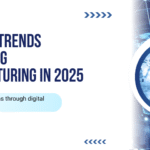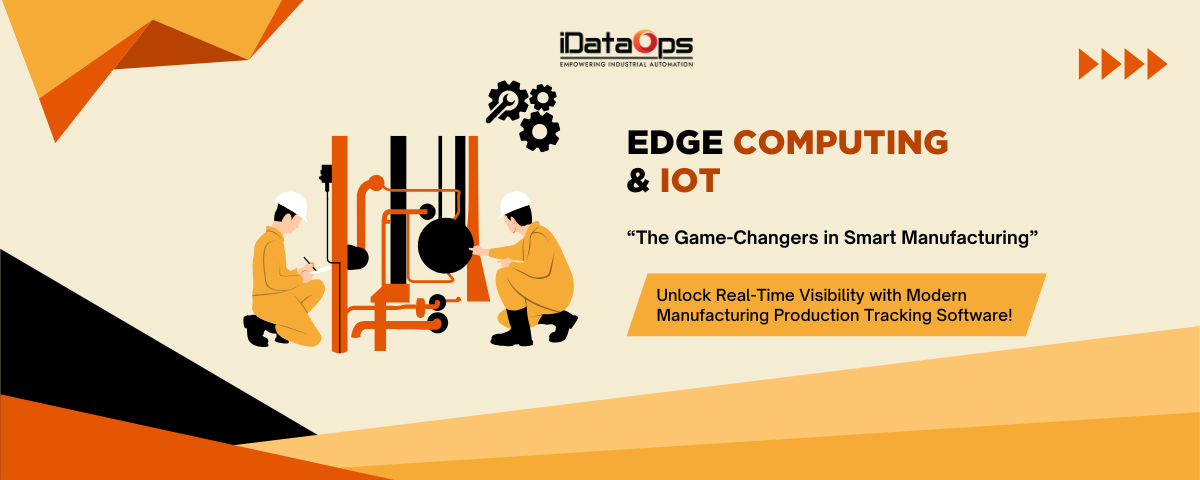
How iDataOps Is Revolutionizing Shop Floor Automation with Real-Time Data Processing
April 14, 2025
Before 2025 Ends: 5 Digital Transformation Shifts That Redefined Manufacturing As 2025 draws to a close, one thing is clear: digital transformation in manufacturing has matured. For years, it was a buzzword—an item on the strategic roadmap that always seemed a few quarters away. But this year, digital transformation finally moved from planning slides to production floors. Plants are smarter, data flows freely, and decisions that once took hours now happen in real time. The technologies themselves—AI, IoT, and cloud computing—aren’t new. What changed in 2025 is how manufacturers used them: practically, purposefully, and at scale. Here are five key digital transformation shifts that defined manufacturing in 2025—and how they’re setting the stage for what’s next. 1. Predictive Maintenance Became the New Normal Remember when predictive maintenance was more promise than practice? In 2025, that changed. With IoT sensors, edge devices, and AI models now standard in many facilities, manufacturers can continuously monitor machine health. Instead of reacting to breakdowns, they’re predicting them—sometimes weeks in advance. The result? Downtime dropped dramatically, especially in high-volume lines. Equipment life extended, thanks to proactive scheduling. Maintenance teams gained efficiency, planning work around production instead of halting it. Predictive maintenance is no longer a pilot program—it’s part of the everyday playbook, quietly saving millions in lost productivity across the industry. 2. Smart Factories Scaled Beyond Pilots In 2025, the term “smart factory” stopped meaning a single connected cell or test line. This year, manufacturers scaled digital capabilities across entire facilities—and even global operations. Digital twins, once experimental, are now core to design, simulation, and process optimization. Real-time dashboards give leaders visibility across continents. And AI-driven control systems automatically fine-tune settings for speed, quality, and energy use. The biggest success stories weren’t about tearing down legacy systems. They came from companies that integrated what they already had, connecting MES, ERP, and machine-level data into unified, data-driven networks. Smart manufacturing in 2025 wasn’t about being futuristic—it was about being efficient, flexible, and resilient. 3. Sustainability Became an Operational Metric, Not a Mission Statement Sustainability officially moved from aspiration to execution. By the end of 2025, most major manufacturers are tracking carbon, energy, and material usage as closely as they monitor production yield. Energy-management systems now feed directly into operational KPIs. Waste reduction is automated through smart materials tracking. Even procurement decisions are guided by sustainability data. Regulators, investors, and customers all demanded more transparency—and the industry responded. The companies that treated sustainability as a design constraint rather than an afterthought discovered a powerful advantage: lower costs and higher efficiency. Sustainability is now a core measure of performance, not just a section in the annual report. 4. Cloud-Connected Operations Quietly Transformed the Shop Floor If one enabler made all these changes possible, it was the cloud. In 2025, manufacturers stopped debating “cloud-first” strategies and focused on being cloud-capable—connecting people, processes, and systems in real time. From global data sharing and supplier integration to automated software updates and analytics-as-a-service, the cloud became the invisible backbone of manufacturing agility. And with hybrid architectures—edge computing on the floor, cloud analytics in the background—factories finally struck the balance between speed and scalability. This quiet shift made collaboration seamless, decisions faster, and innovations repeatable across multiple plants. 5. The Workforce Was Augmented—Not Replaced In 2025, digital transformation proved it’s not about replacing people—it’s about empowering them. Facing retirements, skills shortages, and rising complexity, manufacturers turned to digital tools to enhance human expertise. AR and wearable tech allowed operators to access real-time guidance and remote support. AI assistants offered recommendations for complex troubleshooting. And digital work instructions replaced paper manuals, helping new workers reach proficiency faster. The result? A more connected, capable, and confident workforce—where technology complements human judgment instead of replacing it. What 2025 Taught Us: Progress Is Practical The companies that thrived in 2025 weren’t the ones chasing buzzwords. They were the ones focused on making things work—across systems, across teams, and across time zones. They: Connected existing assets instead of replacing everything. Focused on data quality, not just data quantity. Made automation a support tool, not a control mechanism. Treated sustainability and resilience as part of operational excellence. The year proved that digital transformation doesn’t need to be flashy—it needs to be functional. Looking Ahead to 2026: From Connected to Autonomous As manufacturers move into 2026, the focus is shifting from connected operations to autonomous ones. AI systems will increasingly manage repetitive decisions, freeing humans to focus on innovation and improvement. But the key lesson from 2025 remains: the most advanced factories are the ones where technology and people evolve together—driven by data, guided by experience, and united by purpose.Before 2025 Ends: 5 Digital Shifts Powering the Next Era of Manufacturing
April 28, 2025Edge Computing and IoT: The Dynamic Duo Transforming Manufacturing Operations in Industry 4.0
Manufacturing has always been about precision, speed, and efficiency. But in today’s Industry 4.0 landscape, data has become just as critical as machinery. The ability to collect, analyze, and act on that data in real time is now a key differentiator. That’s where Edge Computing and the Internet of Things (IoT) come in—working hand in hand to reshape how factories operate on a daily basis.
At the center of this shift is manufacturing production tracking software, which brings these technologies together to create smarter, more responsive, and more connected shop floors.
What’s Really Going on with Edge and IoT?
Let’s break it down simply.
IoT connects machines, devices, and sensors on the shop floor. These devices constantly collect data—machine speed, temperature, cycle time, part quality, energy usage, and more. The problem? There’s a lot of data.
That’s where Edge Computing makes a difference. Instead of sending all that raw data to a central server or the cloud—where it can take seconds or even minutes to process—edge computing handles it locally, right at the source. That means decisions can be made in real time, where and when it matters most.
Why This Matters on the Shop Floor
In a typical factory, speed is everything. Delays in detecting a machine fault or catching a quality defect can lead to wasted materials, missed deadlines, or worse—costly downtime. Edge + IoT eliminates that lag.
When integrated with modern manufacturing production tracking software, the result is a live view of what’s happening across your entire operation—down to the individual machine level. You’re no longer waiting for reports at the end of the day. You’re seeing the data as it happens.
Key Benefits for Manufacturers
1. Faster Decision-Making
Say a machine starts vibrating outside of normal parameters. With edge-enabled IoT, that data is processed locally and the system can automatically notify a technician or even shut the machine down if needed—within milliseconds.
2. Better OEE Without the Guesswork
If you’re measuring Overall Equipment Effectiveness (OEE)—and you should be—edge computing makes it easier to track availability, performance, and quality in real time. Using OEE tracking software that pulls from edge-processed IoT data, manufacturers can respond immediately when something starts affecting throughput or yield.
3. Smarter Predictive Maintenance
Rather than waiting for a machine to fail and reacting to it, IoT sensors paired with edge analytics can recognize early warning signs. This allows maintenance teams to fix issues before they become critical—saving time and avoiding unexpected downtime.
4. Real-Time Quality Control
When sensors can flag defects the moment they occur, you’re not waiting until post-production inspection to realize a batch was off-spec. Instead, production teams can make adjustments on the fly, reducing scrap and improving consistency.
Real Example: From Reactive to Proactive
One mid-sized packaging manufacturer was dealing with chronic downtime and inconsistent batch quality. They had IoT sensors installed, but all their data was going to the cloud, and reports weren’t available until the next day.
Once they implemented edge computing alongside their manufacturing production tracking software, they could visualize performance and quality issues in real time. Downtime dropped by over 20%, and they were able to correct process issues within minutes instead of hours. That’s the kind of difference real-time insight makes.
A New Kind of Factory Floor
The modern factory isn’t just about robotics or automation—it’s about connected intelligence. Machines talking to each other. Systems predicting problems. Dashboards showing live production numbers. Edge and IoT aren’t replacing people or equipment—they’re giving teams the data and tools they need to make better, faster decisions.
And with the right manufacturing production tracking software, that data becomes accessible, visual, and actionable across the organization—from operators and technicians to plant managers and C-level execs.
Looking Ahead
Edge computing and IoT are no longer emerging trends—they’re essential tools in any smart manufacturing strategy. Together, they deliver the speed, transparency, and control that manufacturers need to compete in today’s fast-moving markets.
Whether you’re looking to reduce downtime, improve product quality, or simply get better visibility into your operations, now is the time to explore how this technology can work for you.
Want to see what edge-powered production tracking looks like in action?
Learn how iDataOps is helping manufacturers turn raw data into real-time decisions.



